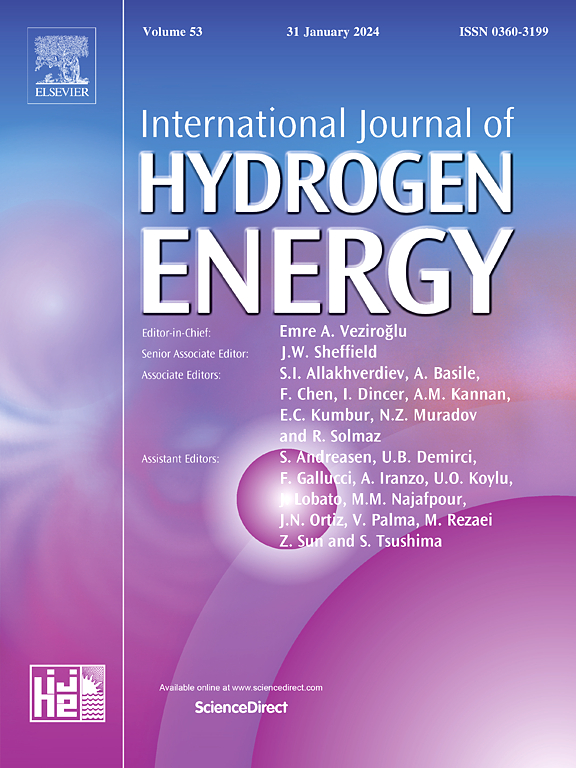Electrophoretic deposition of novel hybrid MnCo2O4: Mn1·7CuFe0·3O4 spinel protective coating on stainless-steel metallic interconnects for SOFCs application
IF 8.1
2区 工程技术
Q1 CHEMISTRY, PHYSICAL
引用次数: 0
Abstract
An innovative hybrid spinel coating, composed of MnCo2O4 and Mn1·7CuFe0·3O4 spinel materials in varying ratios (1:0, 1:3, 1:1, 3:1, and 0:1 wt%), is applied on AISI 441 stainless-steel interconnects by electrophoretic deposition method, to improve electrical conductivity, and inhibit the migration and evaporation of chromium. Stainless steel have been coated with dense, uniform, and crack-free coatings using EPD method. The cross-sectional analysis reveals that the densification of hybrid coatings (1:1 wt%) sintered under reduction treatment (1000 °C for 2 h in H2), followed by a subsequent oxidation treatment (900 °C for 2 h in air) is greater (29 %) than those sintered solely under oxidation treatment (900 °C for 4 h in air). What is more, Raman and XRD study suggests that the applied procedure provides a precise control over the phase composition of the hybrid coating materials. The electrical conductivity of the hybrid materials (1:1 wt%) is higher (45 %) than that of the MnCo2O4 spinel material but lower (36 %) than that of the Mn1·7CuFe0·3O4 spinel material at 600 °C. The novel hybrid spinel coating presents a promising candidate for protective coating on metallic interconnects, due to its higher electrical conductivity, and higher sinterability as compared to Mn–Co spinel coating.
新型杂化MnCo2O4: Mn1·7CuFe0·3O4尖晶石保护涂层在SOFCs不锈钢互连上的电泳沉积
采用电泳沉积方法,将MnCo2O4和Mn1·7CuFe0·3O4尖晶石材料以不同的比例(1:0、1:3、1:1、3:1和0:1 wt%)涂覆在AISI 441不锈钢互连层上,提高了其导电性,抑制了铬的迁移和蒸发。采用EPD法对不锈钢进行了致密、均匀、无裂纹的涂层处理。横截面分析表明,经过还原处理(1000°C在H2中加热2小时),然后再进行氧化处理(900°C在空气中加热2小时)烧结的杂化涂层的密度(1:1 wt%)比单独经过氧化处理(900°C在空气中加热4小时)烧结的杂化涂层的密度(29%)要大。此外,Raman和XRD研究表明,该应用程序可以精确控制杂化涂层材料的相组成。600℃时,杂化材料的电导率(1:1 wt%)高于MnCo2O4尖晶石材料(45%),但低于Mn1·7CuFe0·3O4尖晶石材料(36%)。与锰钴尖晶石涂层相比,新型杂化尖晶石涂层具有更高的导电性和烧结性能,是金属互连保护涂层的理想选择。
本文章由计算机程序翻译,如有差异,请以英文原文为准。
求助全文
约1分钟内获得全文
求助全文
来源期刊

International Journal of Hydrogen Energy
工程技术-环境科学
CiteScore
13.50
自引率
25.00%
发文量
3502
审稿时长
60 days
期刊介绍:
The objective of the International Journal of Hydrogen Energy is to facilitate the exchange of new ideas, technological advancements, and research findings in the field of Hydrogen Energy among scientists and engineers worldwide. This journal showcases original research, both analytical and experimental, covering various aspects of Hydrogen Energy. These include production, storage, transmission, utilization, enabling technologies, environmental impact, economic considerations, and global perspectives on hydrogen and its carriers such as NH3, CH4, alcohols, etc.
The utilization aspect encompasses various methods such as thermochemical (combustion), photochemical, electrochemical (fuel cells), and nuclear conversion of hydrogen, hydrogen isotopes, and hydrogen carriers into thermal, mechanical, and electrical energies. The applications of these energies can be found in transportation (including aerospace), industrial, commercial, and residential sectors.
 求助内容:
求助内容: 应助结果提醒方式:
应助结果提醒方式:


